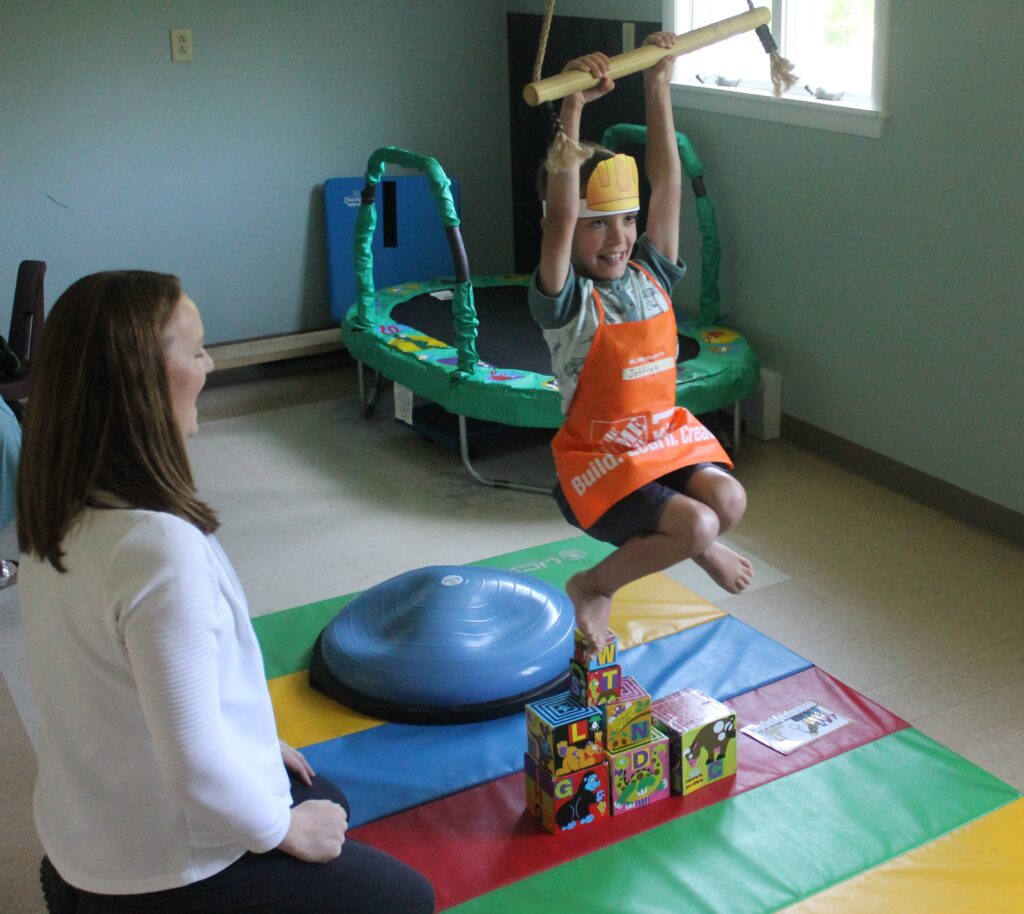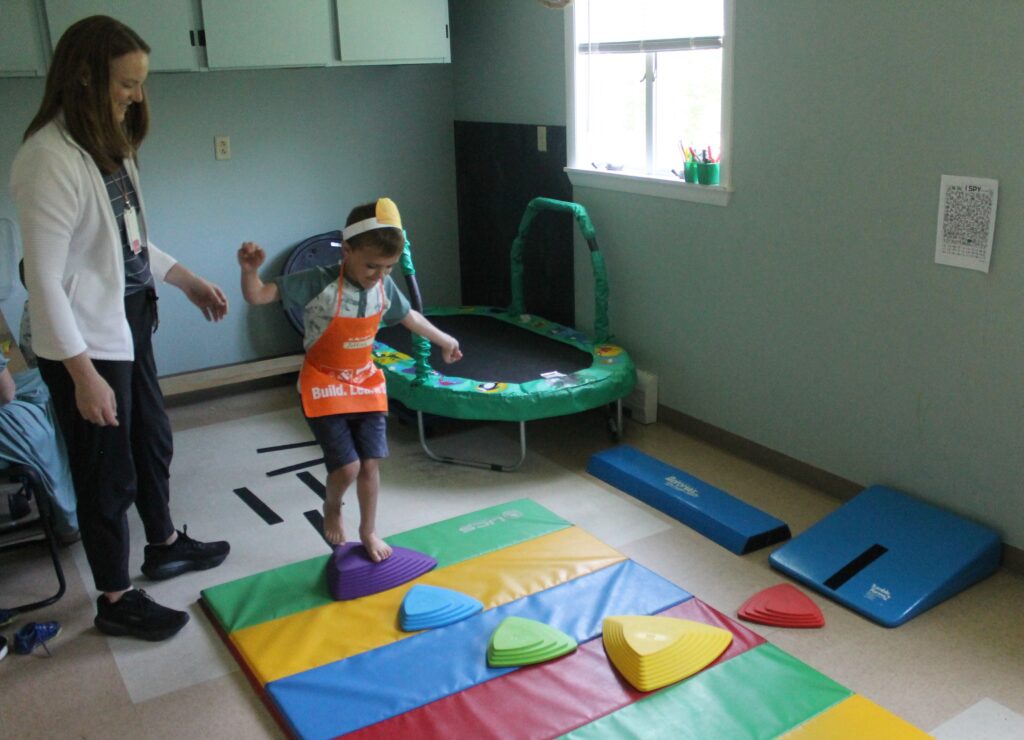
Play time is an important part of CA Dean pediatric occupational therapy
SANGERVILLE — When 7-year-old Jeffrey Landry of Parkman stops by Northern Light CA Dean Hospital’s pediatric occupational therapy room on Haley Court in Sangerville he swings from a trapeze, jumps on a trampoline, goes through an obstacle course and finds a specific object in a collage of various images.
Landry is not just having fun but the play time also serves as therapy time as he and other young patients work to overcome their challenges.
Play is a primary part of the individualized treatment plans that CA Dean’s pediatric occupational therapists develop for their patients. Individualized play encourages children to buy into therapy while helping them meet development milestones and overcome sensory challenges.

PLAY TIME IS THERAPY TIME — Jeffrey Landry, 7 of Parkman, swings on the trapeze under the watch of Occupational Therapist Bryanne Lovell, MSOTR/L, CLC in a Northern Light CA Dean Hospital pediatric occupational therapy room in Sangerville. The program for young patients has fun exercises to keep them engaged and help them meet goals.
Occupational therapy helps people develop the skills they need to join in everyday activities to lead a full and happy life. Pediatric occupational therapists build treatment programs specific to a child, their goals and their environment. For children and infants, play and clinical techniques build the physical and emotional tools they need every day to improve their physical, social, and emotional development, sensory processing skills and cognition.
Northern Light Health has pediatric occupational therapists statewide to help children improve their fine motor skills, learning skills, social and emotional skills and activities of daily living including dressing, eating and toileting. Many patients have developmental disabilities including autism spectrum disorder, attention deficit hyperactivity disorder, cerebral palsy and intellectual disability.
For about three years Landry has been working with CA Dean Occupational Therapist Bryanne Lovell, MSOTR/L, CLC (she also has worked with his siblings). Lovell develops activities to meet the needs and therapy goals of Landry and other patients with everything being play-based. His weekly sessions last for 30-45 minutes.
“A big piece of therapy, especially with kids, is building a good rapport,” Lovell said. She said this helps get the young patients to buy into the sessions.

STEP BY STEP — Jeffrey Landry proceeds along stepping stones in an obstacle course in the Northern Light CA Dean Hospital pediatric occupational therapy room in Sangerville. For three years Landry has worked with Occupational Therapist Bryanne Lovell, MSOTR/L, CLC.
Lovell mentioned she knows that Landry likes cows and previously sloths were one of his favorite animals.
“We try to do themed weeks just to keep things interesting,” Lovell said during a recent session with Landry during a construction week. Soon after coming into the room with his mother Landry got to put on a construction apron and replica paper construction helmet attached to a headband.
His first activity involved a trapeze as Lovell had him stack some blocks in a specified pattern. Once in place Landry grasped the wooden bar as he swung and avoided the stack several times before getting to knock it over.
Doing so helped Landry work on his upper body strength and strengthened his core as Lovell asked him to tuck his knees under his body. The fun exercise also had the young patient work on visual perception as he was asked to copy a pattern he saw on a sheet as well as following directions from Lovell.
“Knees up to your body before you look,” she said as Landry got in place on an elevated pad prior to his swing.
For the inch worm exercise, Lovell placed mixed up pieces to a pair of puzzles on a mat. Landry began by standing but he needed to keep his feet in place before putting his hands on the multicolored match and stretch a distance comparable to his height to reach the pieces and then come back to assemble the images.
“There is generalized strengthening here, following directions and audio processing,” Lovell said. “Visual perception too.”
Humming aloud while reaching for the pieces, Landry quickly had the puzzles together. After he was done Lovell asked for a high five as they celebrate successes big and small.
For Lovell, the best part of being a pediatric occupational therapist is using her creativity and clinical skills to develop therapeutic treatments that can change kids’ lives.
Landry and Lovell proceeded to “tool time movement” as specific construction tools on a chart meant Landry needed to perform a certain action such as clapping with a hammer, swinging his arms as if he was using a handsaw, spinning in place for a drill and giving a big stretch for a tape measure.
For a version of “I Spy” Landry jumped five times on the trampoline and went through a small obstacle course as he hop scotched his way over some lines and stepping stones. Before Landry started his first run-through Lovell asked him to find a truck so after going from trampoline to the course end he got to a collage of images. There he located the requested truck and colored it in.
“We’re working on balance, coordination, following multi-step directions and there’s some sensory elements here with the trampoline and using the stepping stones and visual scanning,” Lovell said.
The activities vary with time to keep the sessions fresh and new for the young patients.
“It is a challenge every week to come up with something new to engage him, but we have a great team to share ideas with,” Lovell said.
One annual week everyone involved looks forward to — some families adjust their vacations to be home for this week — is a water week featuring activities outside on the back lawn.
“Kids love water week, it is a fun way to do something different and reward them for all the hard work they put in during therapy,” Lovell said.
The week’s activities include an obstacle course, balloon tosses, painting with shaving cream on a shower curtain, cup stacking, a slip ‘n slide and more.
“It’s a great way to visualize them playing and you adopt activities to be therapeutic for them,” Lovell said.
She said shower curtain painting requires the child to squat low to the ground and use their upper body to paint the upright shower curtain. Being outside adds to the sensory processing challenges as the patients work on coping with emotions they may experience.
“‘What are we going to do to calm down, let’s look at the tools we have,’’ she may ask the child when they are working through everything while being outside.